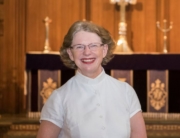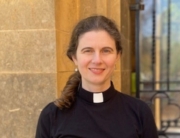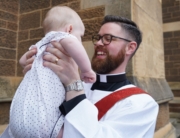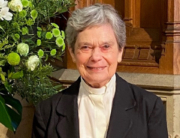Preacher: The Rev’d Jenny Wilson, Canon Precentor
In the name of God, creating, redeeming, sanctifying, … Amen.
“They have no wine.”
Wine symbolises life.
“The life source is gone.” The source of life, of joy, of exuberance, has dried up, is finished. “They have no wine.”
It is the mother of Jesus who points this out to him. The story of her giving birth to him is not told in this gospel according to John. No, this gospel begins well before Jesus’ birth, it begins at creation’s birth. But Jesus’ mother gives birth to his first sign. She invites him to notice and respond to this terrible lack, this lack of wine at a wedding, and in so doing she invites him to begin his revelation of who he is, and more importantly who God is.
The mother of Jesus appears twice in this gospel, at the wedding at Cana, the account of which we read in this morning’s gospel reading, and at his death. At the moment when he restored life to a wedding feast. And at the moment when blood and water streamed from his pieced dead side, pouring life and spirit into creation.
This morning’s gospel reading from the gospel according to St John contains the story of Jesus turning water into wine at the wedding at Cana. John’s gospel is woven with symbolism and this story is no different. Before we look more closely at the story we have read we need to think a little about the opening and closing scenes from this gospel of John.
John’s gospel opens before the dawn of time, with a Prologue that echoes the Genesis account of creation. It gives the ground upon which the whole gospel story is told.
In the beginning was the Word, and the Word was with God, and the Word was God. ….What has come into being in him, [Jesus], was life,* and the life was the light of all people. The light shines in the darkness, and the darkness did not overcome it. …
14 And the Word became flesh and lived among us, and we have seen his glory, the glory as of a father’s only son,* full of grace and truth. (John 1:1, 3-5, 14)
Jesus, the Word of God, came, lived among us, that we might have life, that we might become children of God. Jesus came, that God’s glory might be revealed. This we read in the beginning of the Gospel according to St John.
And, importantly for our passage, very near the end of the gospel, the writer tells us the reason for his writing:
Now Jesus did many other signs in the presence of his disciples, which are not written in this book. 31But these are written so that you may come to believe* that Jesus is the Messiah,* the Son of God, and that through believing you may have life in his name. (John 20:30-31)
The gospel is written that we might believe …and have life in his name. That we might believe and have life. That is what this mighty gospel is for. So let us look more closely now at this wedding scene, the scene where Jesus performed his first sign. A sign points beyond itself to something. It nurtures the question, “What is happening here?” It causes us to wonder.
The scene opens with the words ‘on the third day’. These words would have an immediate resonance with hearers familiar with the Old Testament. When Moses has led the Israelite people into the wilderness, in one encounter with the Lord,
The Lord said to Moses: ‘Go to the people and consecrate them today and tomorrow. Have them wash their clothes and prepare for the third day, because on the third day the Lord will come down upon Mount Sinai in the sight of all the people.…(Exodus 19:10-11)
The words ‘on the third day’ would lead to an expectation that God is to be revealed in some way. We well remember that the ultimate revelation of God’s glory, as John puts it, was revealed in Jesus being raised on the third day.
So the very opening of this story tells us that we might be open to the possibility of God.
The setting of the story is a wedding feast. Again, in the writing of the Old Testament, God is at times portrayed as a bridegroom longing to be united with God’s people Israel. The love of a marriage is a symbol of God’s abiding love, of God’s abiding longing to be deeply connected with God’s people. And so we sense that God’s desire to love God’s people is at hand.
But there is a problem at this wedding. “They have no wine.” The wine has run out. Wine is the source of joy and exuberance at a feast. The source of life has run out. Jesus, we remember from the Prologue of John’s gospel, was life, lived among us that we might have life. The truth expressed in the beautiful poetry of the prologue is now to be enacted in this first sign. The wine has run out at the wedding at Cana. The mother of Jesus is the one who sees. She goes immediately to her son and tells him.
His response is strange. “Woman, what concern is that to you and to me? My hour has not yet come.” The scholar Michael Fallon suggests a different translation of these words, a translation that he believes is more faithful to the original text. He believes Jesus is saying to his mother, “Are you seeing this the way I see it? Woman, has not my hour now come?”[1] He seems to be inviting her to ponder how God wishes them to be involved in the situation. “Are you seeing this the way I see it?” Surely his mother does see the situation the way he sees it. She has come to him and her faith is palpable. She tells the servants to do whatever he tells them to do. Jesus’ hour, in the gospel of John, is the time of the crucifixion, but Jesus is affirming that at this time, in this first sign, he is to begin to reveal who he is, and what he has come to do.
Now standing there were six stone water-jars for the Jewish rites of purification, each holding twenty or thirty gallons. 7Jesus said to them, ‘Fill the jars with water.’ (John 2:6-7)
These water jars were most likely present to enable the ritual cleansing of hands at a meal. The jars are empty, waiting to be filled. In this turning of water into wine, Jesus creates something new in the midst of the Jewish culture.
The water has become wine, good wine, in abundant supply. This is an extravagant action, it is profoundly generous. This wine is a gift of extraordinary grace.
The gospel writer concludes his account:
Jesus did this, the first of his signs, in Cana of Galilee, and revealed his glory; and his disciples believed in him. (John 2:11)
Jesus is indeed present, full of grace and truth. The truth being that where life and joy and is lacking, Jesus brings abundant life. The glory of God is revealed in this first sign, this sign that contains the key revelation – that of God’s great love. And the disciples believed. Michael Fallon defines “believe” as “to be in God’s love, receiving with an open heart the love which God is”.[2]
“They have no wine.” We could gaze at so many situations in our world and say those words. Sometimes we look at one another, in our families or our workplaces or our communities, and if we have the courage of the mother of Jesus we might say, “We have no wine.” Do we dare to speak her words, to see what she sees? Could we imagine Jesus saying to us “Are you seeing this the way I see it?” Is it a time to be in God’s love, receiving with an open heart the love which God is? Can we believe, when the wine, the life source, seems to have run out? Can we, like Jesus mother, go to him and see ourselves and the world in which we live the way he sees it?
A sign such as this causes us to wonder. What is Jesus doing here? Can it possibly be that here the great love of God is being revealed? Might we allow the words, “we have no wine” with all their pain, ring in the air, when life seems diminished; might we, like Jesus’ mother, in faith, speak them out aloud. Might we allow the possibility that God in Jesus will hear us and will offer us abundant life?
[1] Michael Fallon, MSC The Gospel according to Saint John p81.
[2] Michael Fallon p88.





